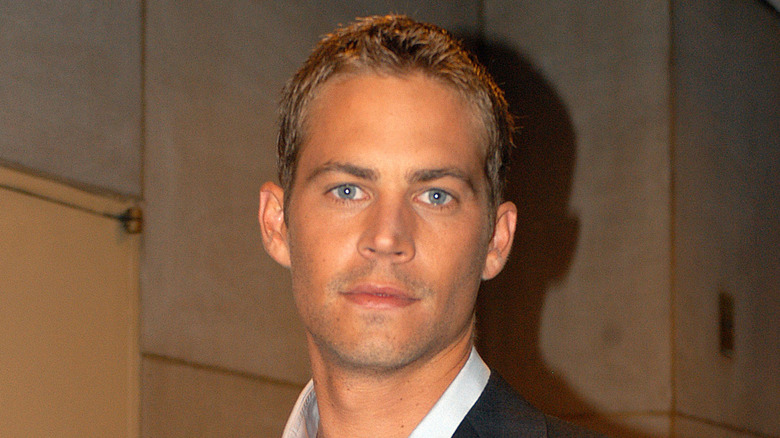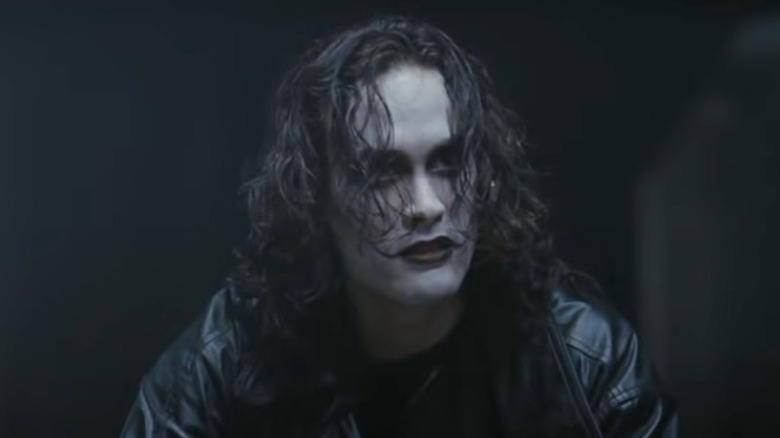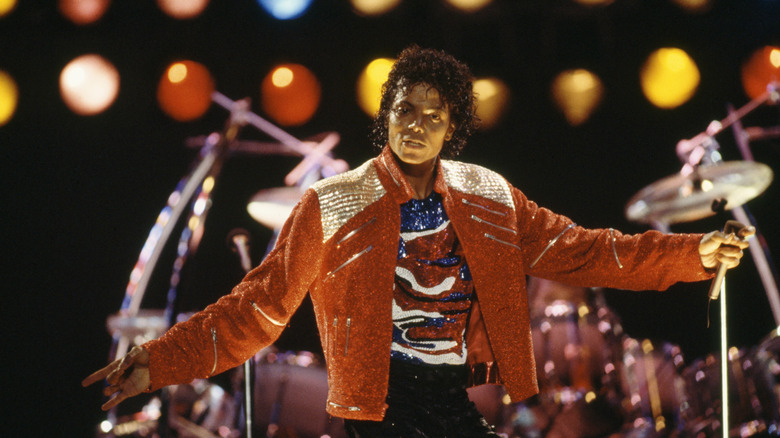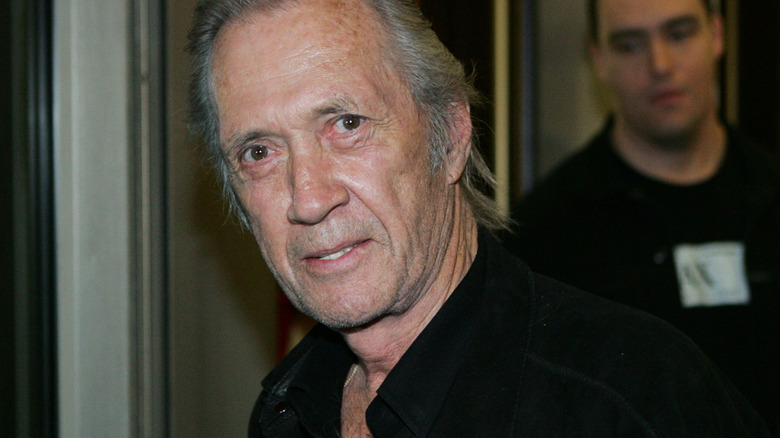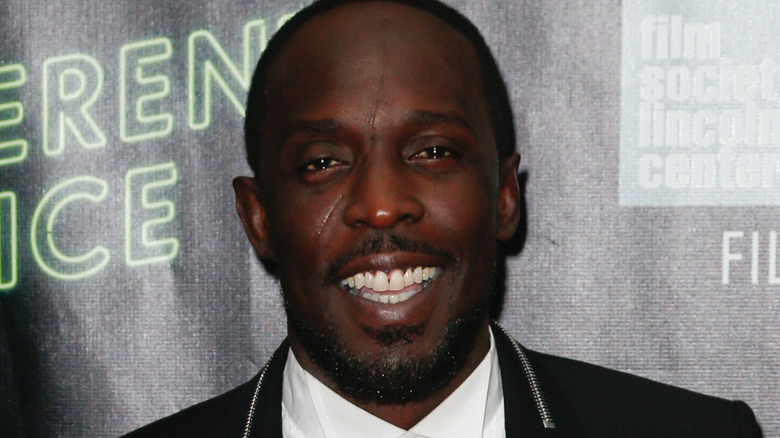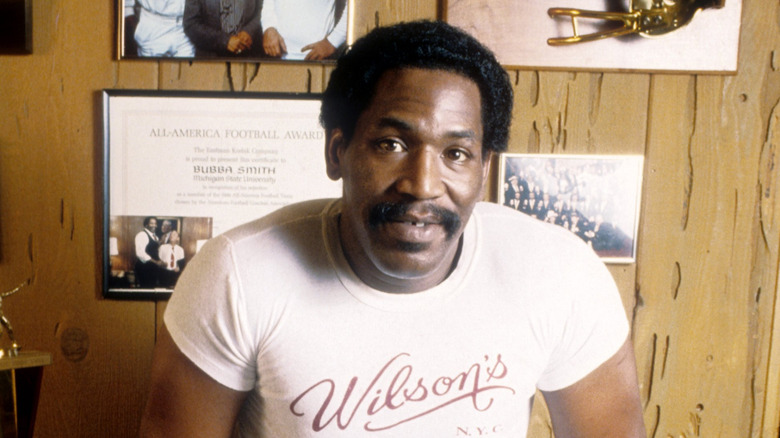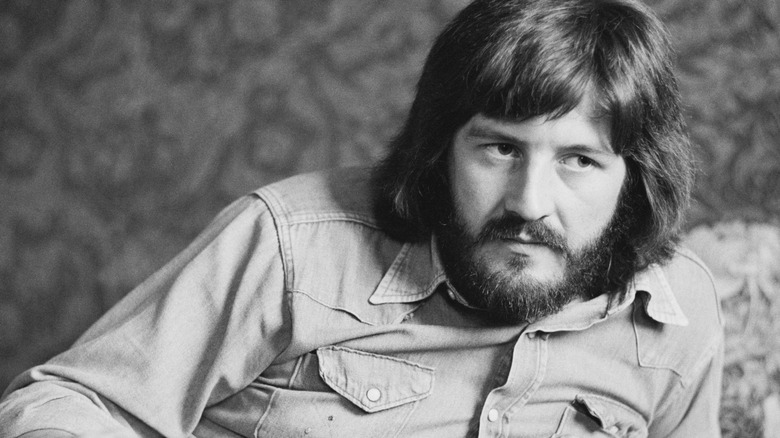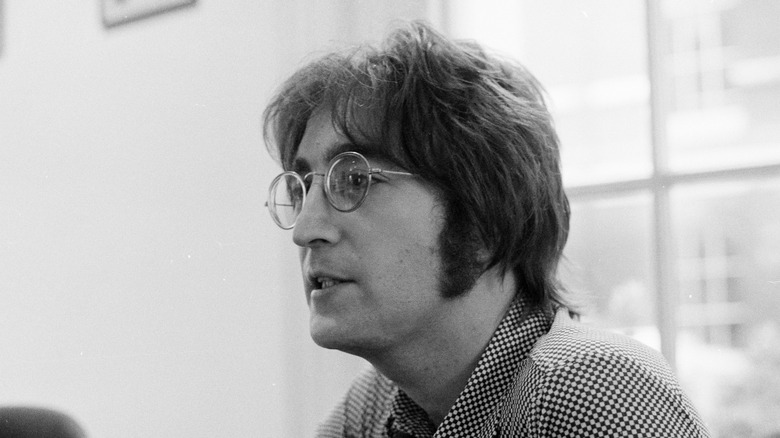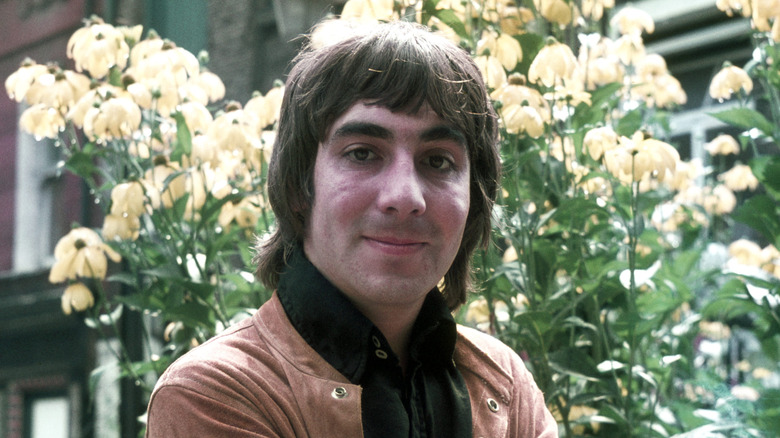Celebrity Autopsies With Disturbing Discoveries
Collectively, we become so enamored with celebrities that we want to know everything about them — how they grew up, who they're dating, who made the clothes they're wearing, and even how they're coping during a personal issue. The insatiable desire to flesh them out and make them seem like people we know personally blurs the lines between public and private, and fact and fiction. Probably nothing is more personal, more exceedingly intimate than when their autopsies are entered into the public record, the curious and often sordid factors of their surprising or early deaths laid out for all the world to see.
They aren't a fun read, but it is interesting (and also heartbreaking) to learn how those seemingly immortal larger-than-life figures shuffled off that proverbial mortal coil. Here are some recent celebrity deaths that shocked the world, until the surprising details of their autopsies stunned us even more.
This article contains references to addiction and mental health issues. If you or anyone you know needs help with addiction issues and/or mental health issues, contact the relevant resources below:
-
The Substance Abuse and Mental Health Services Administration website or contact SAMHSA's National Helpline at 1-800-662-HELP (4357).
-
The Crisis Text Line by texting HOME to 741741, call the National Alliance on Mental Illness helpline at 1-800-950-NAMI (6264), or visit the National Institute of Mental Health website.
Advertisement
Prince
The music world, and music fans around the world, mourned deeply when Prince died suddenly in April 2016. A talent for the ages, Prince ruled the '80s and '90s with his hard-to-pigeonhole combination of R&B, pop, soul, funk, and rock, and he was among the very best to ever sing, play guitar, write music, or dance. Among the classic tunes for which Prince is responsible: "Purple Rain," "Little Red Corvette," "Raspberry Beret," and "When Doves Cry."
Two employees discovered the body of Prince in an elevator at his Paisley Park home and recording complex; the musician had died at least six hours earlier. Some of the many things we learned after Prince died came from an autopsy released six weeks after Prince's death, which cited the cause of death as an accidental overdose of the synthetic opioid fentanyl, a clinical and extremely potent painkiller. (Prince had suffered from, and had surgery on, a hip made weak by years of acrobatic and adventurous dancing and performing.)
The toxicology report from that autopsy listed in intricate detail just how much narcotic substances were in Prince's system when he died at age 57. Fentanyl was present in the musician's blood at a rate of 67.8 micrograms per liter; fatal doses of 3 to 58 micrograms have been previously recorded. The concentration of the drug in Prince's liver registered at 450 micrograms per kilogram; experts believe a level of 70 micrograms per kilogram is almost certainly deadly.
Cory Monteith
Almost as shocking as the death of 31-year-old actor Cory Monteith was the nature of how he died — it was so utterly counter to his public persona and the character for which he was best known, sweet jock-turned-singer (and lunkheaded boyfriend) Finn Hudson on Fox's mega-popular teen musical dramedy "Glee."
In July 2013, Monteith's body was discovered in his room at the Fairmont Pacific Rim Hotel in Vancouver. His death came just a few months after he entered a rehabilitation facility to treat substance abuse issues that began when he was 13, when he'd cut classes to drink and smoke marijuana. Monteith attempted to parlay his issues into his art, convincing director Josh C. Waller to cast him as a drug-addicted character in the indie drama "McCanick." "He was like, 'I can do this character. I know this character. I was this character. I have lived elements of this,'" Waller told People.
According to a coroner's report, Monteith had been dead for hours by the time he was discovered. Authorities also recovered paraphernalia, including a "spoon with drug residue and a used hypodermic needle" and two empty champagne bottles, consistent with the ruling that the actor died of a mixture of alcohol and heroin.
Brandon Lee
Due to an abundance of caution and protocol, fatal accidents on big movie productions are exceedingly rare. That makes it all the more tragic when someone does lose their life while making a film. By 1993, after some rebellious teenage years, Brandon Lee was one of the fastest-rising stars in Hollywood. The son of late martial arts and movie legend Bruce Lee, the 28-year-old actor had starred in a couple of action movies and was primed to break out big with "The Crow," Alex Proyas' film adaptation of the dark, violent, cult classic comic series about deceased rock star Eric Draven who becomes an avenging angel, killing the thugs and criminals who murdered him and his girlfriend.
One scene in "The Crow" called for actor Michael Massee, portraying the film's chief villain, to shoot Draven/Lee from a close distance. Unbeknownst to Massee, a fragment from a previously used projectile had stuck in the barrel of the prop gun. When the actor fired, the gunpowder inside the blank cartridge sent the fragment into Lee. The actor died after six hours of surgery proved futile.
Medical examiners found a .44-caliber bullet lodged in Lee's spine, and believe that part of it tore into the actor's abdomen. There were found to be a multitude of things about Lee's death that made no sense, and it led to questions being raised about weapons procedures on movie sets. For one, the bullet that killed him had apparently been used for a close-up shot, and not properly discarded.
Carrie Fisher
A celebrated author, memoirist, and screenwriter, Carrie Fisher achieved pop culture immortality in her early twenties when she portrayed Princess Leia Organa in the original "Star Wars" and many of its sequels. The franchise's countless fans went into deep mourning in December 2016, when the 60-year-old went into cardiac arrest on a flight from London to Los Angeles. As soon as the plane touched down, Fisher was rushed to an LA hospital, where she died soon thereafter.
Fisher's ultimately tragic misuse of illicit substances was well-known and well-documented, particularly in her own books and one-person shows. "I would tell you, from my perspective, that there's certainly no news that Carrie did drugs," Fisher's brother, Todd Fisher, told Entertainment Tonight. "If you want to know what killed her, it's all of it," he added, referring to the results of his sister's autopsy, made public in June 2017.
A toxicology review found evidence of methadone, cocaine, alcohol, MDMA (better known as the party drug ecstasy), and opiates, including an "exposure to heroin," in Fisher's body. However, medical examiners listed Fisher's official cause of death as sleep apnea.
Brittany Murphy
After a white-hot career in the mid-1990s and early 2000s with big roles in "Clueless," "Girl, Interrupted," and "8 Mile," Brittany Murphy's career cooled off considerably. At the same time, she became a tabloid fixture for her personal life, particularly after she married fringe movie industry figure Simon Monjack, whom friends of Murphy accused of being responsible for his wife's rapid weight loss.
Murphy died at age 32 in December 2009. What was shocking is that the actor's death didn't make much sense, as Murphy had died from something relatively mundane and often preventable: pneumonia. However, Murphy's autopsy revealed some disturbing details. In February 2010, a coroner's report cited menstrual flow that triggered a serious case of anemia (an iron deficiency), which left Murphy in such a weak and immunocompromised state that her body wasn't able to fight off the viral infection. "This was not something that she just got a day or so before," retired medical examiner Dr. Lisa Scheinin said in "What Happened, Brittany Murphy?" (via Us Weekly)."She was walking around with this for some time."
Four years after Murphy's death, her father, Angelo Bertolotti, asked for a lab report to be conducted on his daughter's remains. Technicians discovered an abnormally high presence of heavy metals in a hair sample, according to ABC News. "I have a feeling that there was a definite murder situation here," Bertolotti worked out on "Good Morning America." "It's poison, yes, I know that."
Paul Walker
In a cruel and heartbreakingly ironic twist of fate, the man who made the car-racing-oriented "Fast and Furious" movies an international blockbuster sensation died in a sports car, the victim of a terrible vehicular accident. In 2013, Paul Walker was riding as a passenger in a Porsche Carrera GT when driver Roger Rodas lost control at speeds of around 100 mph. The car crashed and reportedly broke almost in half before bursting into flames. Rodas died in the tragedy, and his autopsy showed that his skull had endured so much damage that it left his brain exposed. The details of Walker's death are equally lurid and disturbing.
According to the Los Angeles County coroner, Walker's body was discovered in a "pugilistic stance," meaning the 40-year-old actor died with his arms up, instinctively trying to shield his head and face from impact. Authorities listed the official cause of death as "combined effects of traumatic and thermal injuries," although Walker also suffered a broken jaw, collarbone, and pelvis. The autopsy suggested that Walker died moments after the crash, as bits of soot were discovered in his trachea, inhaled with his final breath. The fire was particularly devastating — Walker's body was so badly burned that none of his organs were deemed suitable for donation.
Michael Jackson
In June 2009, Michael Jackson was rehearsing for a series of comeback shows he thought might restore him to his status as The King of Pop, a designation earned in the '80s and '90s for huge sales of albums like "Thriller" and "Bad." It wasn't meant to be — on June 25, 2009, his personal physician Conrad Murray found Jackson, 50, not breathing in his bed.
Murray would later be convicted of involuntary manslaughter for his role in Jackson's death. Jackson paid Murray $150,000 a month to treat the singer's ailments, including insomnia, by delivering a nightly dose of the powerful surgical anesthetic propofol. That wasn't the only drug found in Jackson's system after his death — examiners also identified midazolam, diazepam, lidocaine, and ephedrine, serious prescription narcotics that "have no place in an unmonitored setting or in unskilled hands," a physician told CNN.
The autopsy revealed another curious fact. "There was no indication from the autopsy that there was anything anatomically wrong with him that would lead to premature death," Dr. Christopher Rogers reported to CNN. He did, however, note some cosmetic alterations to Jackson's appearance, including lips that had been tattooed pink and a portion of the singer's scalp tattooed black to make wigs blend in more naturally with his hairline.
Heather O'Rourke
Heather O'Rourke sadly didn't live long enough to compile a lengthy resume of movie and TV appearances, but she nevertheless made a major and memorable impact on mainstream horror films. O'Rourke made her big-screen debut in the 1982 scary classic "Poltergeist" as Carol Ann Freeling, the towheaded child who gets sucked into another dimension (via a TV) by angry spirits. She also delivered the film's creepy, iconic line, "They're heeeeeere," and reprised her role in two "Poltergeist" sequels. The final leg of the trilogy hit theaters on June 10, 1988, four months after O'Rourke died, mere weeks after her 12th birthday.
O'Rourke experienced abdominal pain so severe that she was urgently taken to Children's Hospital of San Diego. She died during an emergency surgery, and a hospital spokesperson told reporters that the cause of death was related to intestinal stenosis, an extremely serious bowel obstruction that O'Rourke unknowingly had her entire life. The stenosis brought on an infection, which in turn caused septic shock, triggering cardiac and pulmonary arrest.
Tawny Kitaen
Tawny Kitaen was perhaps the quintessential "video vixen" in the 1980s, the era where hard rock and hair metal bands performed songs about overwhelming feelings of love, lust, and affection. Those musicians needed someone to embody those of whom they sang, and so a scantily-clad Kitaen starred in many music videos, notably "Here I Go Again" and "Is this Love" by the band Whitesnake. Kitaen's other notable work includes the Ratt video "Back for More," the 1984 Tom Hanks movie "Bachelor Party," and the early 1990s reboot of "WKRP in Cincinnati." In more recent years, Kitaen's highest-profile appearance was a stint on the second season of "Celebrity Rehab with Dr. Drew" in 2008, in which she sought treatment for her addictions to cocaine and prescription painkillers.
In May 2021, Kitaen died at her home in Newport Beach, California, at age 59. Five months later, the Orange County Coroner's Office released the findings of an autopsy performed on the late actor. Officials ruled her death to be the result of natural causes, specifically dilated cardiomyopathy, or an enlarged heart that can't effectively pump blood. Mild coronary atherosclerosis, a buildup of cholesterol and fatty deposits in the arteries, contributed to the heart malfunction. Additionally, medical examiners found small amounts of prescribed antidepressants and anti-anxiety medications in Kitaen's system.
David Carradine
A member of the Carradine family — his father was character actor John Carradine, and his brothers include Keith Carradine and Robert Carradine — David Carradine served in the Army before going into the family business. He found his breakout role as Kwai Chang Caine on the cult 1970s TV action show "Kung Fu," and enjoyed a major career resurgence when he starred as the titular, ominous villain in Quentin Tarantino's two-part "Kill Bill" saga in the early 2000s.
Carradine wouldn't get to enjoy his comeback for long. In June 2009, the 72-year-old actor was found dead in a Bangkok hotel room. Initially, police in Thailand reported that Carradine had died of asphyxiation by hanging, as crime scene photos depicted a rope around his neck. Carradine didn't leave a note, and with all other things considered, authorities didn't believe any foul play took place but also didn't immediately rule out death by suicide. Other bits of evidence from the scene, such as how the rope was wrapped around Carradine's genitals, and that he was wearing a wig and fishnet stockings, suggested that the actor died as the result of a sex act gone awry.
"The cause of death was asphyxiation, an inability to breathe," forensic pathologist Dr. Michael Baden said. "He didn't die of natural causes, and he didn't die of suicidal causes from the nature of the ligatures around the body, so that leaves some kind of accidental death."
Johnny Lewis
In the early 2000s, rising star Johnny Lewis landed big roles on "Malcolm in the Middle," "Boston Public," "American Dreams," "Smallville," and "The O.C." Around this time, he also dated Katy Perry for a year and played Half-Sack on "Sons of Anarchy," which he quit because he'd tired of the show's violent storylines.
After leaving the FX biker drama, Lewis endured a number of personal and legal challenges. He went through a hard-fought custody battle and was arrested for assault on more than one occasion. When Lewis was released from jail in 2012, the actor's father rented him a room at the Writers' Villa, a mansion operated as a retreat for creatives owned by wealthy arts patron Cathy Davis. After receiving a report of a woman screaming, police arrived at the villa and found Lewis dead in the driveway; he had either fallen or jumped off the building and sustained fatal injuries to his skull. Police then made another grisly discovery: the body of Davis, 81, who, according to a coroner's report, died of strangulation and blunt-force trauma. Detectives believe that Lewis beat Davis (and her cat) to death.
Lewis had a history of drug misuse, and it was assumed that narcotics had something to do with his behavior on the night he died. However, an autopsy uncovered no indication of intoxication.
Michael K. Williams
Michael K. Williams tended to play complicated characters and complex, likable bad guys. His smoldering intensity served him well in the 2000s and beyond, a golden age of TV drama. He brought to life the iconic role of stickup artist Omar Little on the cult classic "The Wire," played racketeer Chalky White on the period drama "Boardwalk Empire," and earned Emmy nominations for his work in "Bessie," "The Night Of," "When They See Us," and "Lovecraft Country." Through all of it, Williams dealt with substance misuse issues.
Williams didn't show up for an engagement on Saturday, September 4, 2021, and a relative went to the actor's penthouse in Brooklyn two days later to see if he was alright. Police were summoned to the home on a report of an unresponsive man lying face down in the dining room. As there was heroin present on a nearby table, Williams' death was initially suspected to be an overdose of the opiate.
About three weeks later, New York City's Office of Chief Medical Examiner announced the results of an autopsy, determining that Williams, 54, died of acute drug intoxication. Heroin was found in the actor's system, along with cocaine and the powerful prescription painkillers parafluorofentanyl and fentanyl.
George Michael
George Michael was a superstar two times over. In the mid-1980s, he was a sweet and smiling teen idol type as one-half of (but the chief creative force behind) Wham!, a pop duo who churned out bubblegum hits like "Wake Me Up Before You Go-Go," "Last Christmas," "I'm Your Man," and "Careless Whisper." By 1987, Michael had gone solo, releasing the blockbuster "Faith," an album full of the music Michael would make for the next decade or so, including mature and sophisticated soul-pop like "One More Try," "I Want Your Sex," "Kissing a Fool," and "Father Figure."
George Michael died on Christmas Day 2016. The 53-year-old singer-songwriter's U.S. manager reported that Michael had not been sick, but had died sometime after he went to bed the previous evening. Michael's partner, Fadi Fawaz (via Twitter), found him "dead peacefully in bed first thing in the morning."
With little to no outward signs or warning of the death, an autopsy was performed on Michael's body. Medical examiners determined that the musician died of a combination of a fatty liver and dilated cardiomyopathy with myocarditis. The latter two causes are diseases of the heart — dilated cardiomyopathy weakens and stretches the left ventricle, diminishing the quality of blood flow, while myocarditis is an inflammation of the whole organ, generally brought on by an infection.
Heath Ledger
First associated with teen movies because of his breakthrough role in the 1999 high school comedy "10 Things I Hate About You," Heath Ledger quickly proved his versatility. In rapid succession, he starred in the war drama "The Patriot," the historical action flick "A Knight's Tale," and "Brokeback Mountain," a modern-day Western about the profound but doomed romance between two male shepherds. Portraying a taciturn, lovesick cowboy landed Ledger his first nomination for an Academy Award, a prize he'd later win for his startling and layered portrayal of comic book villain The Joker in 2008's "The Dark Knight." Sadly, he wouldn't survive to Oscar night.
Shortly after 3 p.m. on January 22, 2008, a housekeeper discovered 28-year-old Ledger face down and nude near the end of a bed in his apartment in New York City's SoHo neighborhood. Police were summoned, and they declared the actor dead at the scene. "We are investigating the possibility of an overdose," NYPD spokesperson Paul Browne said at the time (via Reuters). "There were pills within the vicinity of the bed."
Sleeping pills were discovered near Ledger's body, and according to the results of an autopsy, the medication was present in his system at the time of death. New York City's Medical Examiner's office ruled that Ledger died of accidental acute drug intoxication, having ingested a combination of the prescription painkillers oxycodone and hydrocodone, the anti-anxiety medication diazepam, the sleep aid temazepam, and sedatives alprazolam and doxylamine.
Cameron Boyce
In the 2010s, Cameron Boyce was a near-constant presence on the Disney Channel. The young comic actor played Luke Ross in nearly 100 episodes of the sitcom "Jessie" and on crossovers with other shows, as well as the villainous Carlos Oscar De Vil, son of Cruella De Vil, in three highly-rated made-for-Disney "Descendants" movies. On the big screen, Boyce portrayed Adam Sandler's character's son in two blockbuster "Grown Ups" movies.
On the afternoon of July 6, 2019, Boyce was found unresponsive in his home in Southern California. Authorities were called, and the 20-year-old actor was pronounced dead shortly thereafter. A spokesperson for the Boyce family confirmed the death to ABC News, revealing that the actor "passed away in his sleep due to a seizure which was the result of an ongoing medical condition," which was not publicly disclosed.
The results of the autopsy conducted on Boyce determined that the performer's death was unexpected, accidental, and natural, the result of a seizure related to epilepsy, a neurological condition.
Amy Winehouse
With her throwback style and soulful, dazzling powerhouse vocals, British singer Amy Winehouse earned comparisons to traditional pop singers and jazz greats like Billie Holiday and Sarah Vaughan. A critical and commercial sensation in her native U.K. upon the release of her 2003 debut album, "Frank," Winehouse became a global superstar for her sophomore record, 2006's "Back to Black." The album hit No. 2 on the Billboard album chart, while "Rehab," the jaunty-sounding but lyrically tortured single about Winehouse's addiction issues, made the Top 10. At the 50th Grammy Awards, Winehouse walked away with five awards, including Record of the Year and Song of the Year (for "Rehab") and Best New Artist.
In July 2011, London's Metropolitan police were summoned by ambulance dispatchers to go to a home in north London on a Saturday afternoon, where a woman was found deceased. When they arrived, officers pronounced 27-year-old Winehouse dead.
The results of the first investigation into the cause of Winehouse's death were voided, when authorities discovered that the coroner hired to examine the singer's remains didn't have the proper credentials. A second inquest into Winehouse's death ruled that Winehouse died of alcohol poisoning. After a period of abstaining, Winehouse drank heavily, with a level of 416 mg of alcohol per deciliter of blood, enough to trigger a comatose state and disable her ability to breathe.
Bubba Smith
The defensive end and tackle Bubba Smith was named to two Pro Bowl squads and won the 1971 Super Bowl as a member of the Baltimore Colts. After stints with the Oakland Raiders and Houston Oilers, Smith retired from the NFL in 1976 and successfully transitioned to acting, appearing on TV shows like "Charlie's Angels," "Wonder Woman," and "Vega$" before landing his signature role: quiet but forceful police officer Moses Hightower in 1984's "Police Academy," a part he'd play in five sequels.
In August 2011, Smith, then 66 years old, was found deceased at his home in Los Angeles. A cause of death wasn't immediately discernible, so the Los Angeles County Coroner's office performed an autopsy on the athlete and actor, determining that Smith died from acute drug intoxication — via the weight-loss medication phentermine — and that he also had high blood pressure, several extremely blocked arteries, and a heart about twice the regular size.
After his death, Smith's brain was donated for research, where examiners found evidence of chronic traumatic encephalopathy or CTE, a debilitating injury suffered by numerous former professional football players.
Natalie Wood
Natalie Wood was famous for almost her entire life. At age 9, she costarred in the 1947 holiday classic "Miracle on 34th Street" and as a teenager landed the main female role in "Rebel Without a Cause," then starred in the Oscar-winning "West Side Story" in 1961.
One evening in November 1981, Wood, then 43 years old, joined friend Christopher Walken and her husband, actor Robert Wagner, on the yacht Splendor off the Southern California coast. According to the ship's captain Dennis Davern (via The Daily Beast), the couple got into a heated fight, and there's evidence that Wood left the boat and unsuccessfully tried to sail to land. Whatever the circumstances of the night, Wood's body was found by a lifeguard off Catalina Island hours after her disappearance. The Los Angeles County Coroner called Wood's death the result of an accidental drowning.
Homicide detectives reopened the case in 2011 after receiving new information about Wood's death that the Los Angeles County Sheriff found "intriguing," in the words of spokesperson Steve Whitmore (via CNN). After more investigation, Wood's death certificate was officially edited, the cause changing from "accidental drowning" to "drowning and other undetermined factors." The coroner shared more details in 2013 (via CNN), pointing out that Wood had bruises and abrasions on her body and face that she likely suffered before she hit the water, indicating an assault.
Anna Nicole Smith
From her work as a glamorous model for Guess Jeans to her unclothed pictorials for Playboy to her marriage to an oil tycoon more than 60 years her senior, as well as her E! reality series "The Anna Nicole Show," millions of Americans were captivated with the every move of Anna Nicole Smith for a solid 15 years.
On February 8, 2007, Smith was found unconscious by her personal nurse in her hotel room at the Seminole Hard Rock Hotel and Casino in Hollywood, Florida. Rescue workers transported Smith to Memorial Regional Hospital, where the 39-year-old celebrity died soon afterward. In the immediate aftermath, Smith's death was a mystery, with her attorney reporting that his client had suffered from flu-like symptoms, while local police hauled many bags of evidence out of the reality star's room.
The Broward County medical examiner's office produced an autopsy that ruled Smith's death was the result of an accidental drug overdose. Bottles of 11 prescription drugs originally containing hundreds of pills were recovered from Smith's hotel room, with 600 no longer present, including 450 muscle relaxants and 62 tablets of Valium, an anti-anxiety medication. Another 44 separate prescription drugs were found in Smith's Bahamas home, among them painkillers, opiates, and sleeping pills. Medical examiners pinpointed Smith's death to a toxic and fatal combination of a minimum of nine medications.
Lucille Ball
The undisputed queen of television in the medium's first few decades, Lucille Ball virtually invented the sitcom with "I Love Lucy," which she starred in and helped run with her then-husband, Desi Arnaz. Ball later starred on two more long-running CBS sitcoms, "Here's Lucy" and "The Lucy Show," and branched out into movies and producing before returning to TV for one final show in the mid-1980s, the short-lived "Life with Lucy."
Ball underwent a six-and-a-half-hour heart surgery at Cedars-Sinai Medical Center in LA on April 18, 1989, with doctors replacing an aortic valve and part of the aorta. Within the week, Ball was able to eat and walk around the hospital, only to die eight days later.
The cause of death was determined to be a rupture of the aorta — a main artery — which had not been operated on, leading to heart failure. After 47 minutes of revival attempts, doctors declared the comedian dead at the age of 77.
Forensic pathologist Dr. Michael Hunter revealed in the Reelz series "Autopsy" (via People) that while the ruptured aorta is what killed Ball, her heart had been taxed by the long-term use of amyl nitrate, better known as "poppers," a street drug used to boost the intensity of a sexual encounter. Ball probably wasn't using the inhalant for recreational use. "It's original purpose was as a prescription drug to treat pain in the chest," said Hunter.
John Bonham
Led Zeppelin might be the quintessential classic rock, blues rock, and hard rock band. They're at least one of the most popular acts in history, being the fifth best-selling act in the U.S., with more than 112 albums sold. Over 24 million of those are of the group's 1971 LP "Led Zeppelin IV," which contains some of the band's most famous songs, including "Black Dog," "Rock and Roll," and "Stairway to Heaven." Along with the howling vocals of Robert Plant and the guitar acrobatics of Jimmy Page, those tunes became classic rock staples thanks to the energetic, thunderous drumming of John Bonham.
Bonham's nickname was "Bonzo," which rhymes with "gonzo," an assessment of not just the way he pounded on a drum set, but the way in which he partied. Bonham was a heavy drinker, which he reportedly carried on doing up until the day he died.
In late September 1980, the members of Led Zeppelin met at the Windsor, England, home of guitarist Jimmy Page for rehearsals. According to a coroner's inquest, Bonham drank throughout the day, imbibing as many as 10 quadruple shots of vodka, or the equivalent of 40 servings. Then Bonham passed out and never woke up: The drummer died at the age of 32. The real cause of death wasn't alcohol poisoning, but rather Bonham unconsciously asphyxiating on the vodka his body vomited.
John Lennon
Following a five-year break from music to concentrate on family life, former Beatle John Lennon staged a comeback in November 1980 with "Double Fantasy," a double album recorded with his wife, experimental artist Yoko Ono. Mere weeks later, on December 8, 1980, Lennon signed a copy of the LP outside the Dakota, the building in New York City where he kept an apartment, for a fan named Mark David Chapman. Upon Lennon's return to the Dakota that evening, Chapman was still there, and he produced a handgun which he used to fire four bullets into the musician. Lennon was declared dead at a hospital; he was 40 years old.
New York City's medical examiner Dr. Elliot Gross conducted an autopsy within 24 hours after Lennon's murder, not to determine the cause of death but to investigate exactly how the tragic and grisly events transpired. Two of Chapman's bullets entered through Lennon's back, then pushed through the chest and a lung before exiting. One of the other two bullets fired made contact with Lennon's left shoulder and pierced his left lung, before coming to rest in the neck vicinity. The fourth and final bullet hit a bone in Lennon's arm. The gunshots left Lennon hemorrhaging blood at such a tremendous speed and volume that, coupled with shock, he died almost immediately afterward.
Matthew Perry
Matthew Perry became a full-time actor as a teenager in the 1980s. He'd go on to write for his TV series "Mr. Sunshine" and "The Odd Couple," as well as star in a string of hit films, but Perry would always be inexorably linked with his role as sarcastic quipster Chandler Bing on the monumentally popular sitcom "Friends." Perry also dealt with addiction for much of his life, including alcoholism after starting to drink at age 14, and an addiction to painkillers throughout adulthood. Also diagnosed with clinical depression, Perry sought out cutting-edge ketamine infusion therapy in the 2020s.
On October 28, 2023, 54-year-old Perry was discovered deceased in the hot tub on his property in Los Angeles. An autopsy by the Los Angeles County medical examiner's office determined that the actor drowned, but only after his body shut down from a fatal overdose of ketamine. The volume of the substance in his system was akin to what would be used as a surgical anesthetic, which wouldn't have been administered in a clinical setting.
Perry's final infusion treatment had occurred more than a week before his death, and ketamine is fully out of the body within hours after use. An investigation determined that Perry, after developing a dependency on ketamine, had enlisted the help of multiple people to acquire large amounts of the drug on his behalf.
Anton Yelchin
Born in the Soviet Union, Anton Yelchin was brought to the U.S. at 6 months old when his famous figure-skating parents defected to the U.S. in 1989. He landed dozens of small parts in film and TV as a child actor and broke out in a big way, playing Chekov in the 2009 "Star Trek" big-screen reboot. He'd appear in many more projects and reprise the role of Chekov in two more "Star Trek" movies; the third, "Star Trek Beyond," hit theaters in the summer of 2016, less than a month after Yelchin's death at the age of 27.
After the actor didn't show up for a scheduled rehearsal, Yelchin's friends and costars went to Yelchin's home in Los Angeles and discovered him deceased, trapped between a security gate, a mailbox pillar, and his car. The Los Angeles Police Department's Valley Traffic Division theorized that Yelchin had exited his Jeep Grand Cherokee and left it running in neutral, after which the vehicle rolled and pinned Yelchin where he stood. To figure out the exact nature of the outwardly odd death, the Los Angeles County Coroner's Office performed an autopsy. It corroborated all of the police's initial findings, and determined that Yelchin died within one minute of impact from blunt traumatic asphyxia.
Buddy Holly
Along with Ritchie Valens and The Big Bopper, newly minted early rock n' roll star Buddy Holly headed out on the Winter Dance Party Tour in early 1959 to play shows around the Midwest. Following the stop in Clear Lake, Iowa, on February 2, Holly got so tired of his unreliable tour bus and paid to charter a small plane to get him to the next date in Minnesota. There were a couple of seats left for all of the other various musicians; Valens won his in a coin toss, and Holly's bassist, Waylon Jennings, gave up his to The Big Bopper, who had the flu. Immediately after takeoff, the plane crashed into a field nearby, and everyone on board died upon impact.
The full extent of the ghastliness of the tragic event was only understood after the results of the 22-year-old Holly's autopsy were published. His body was tossed many yards from the plane, and the accident caused his skull to split from the forehead all the way to the back of his head. It was also evident that Holly had bled out through both ears, sustained deep cuts all over his body, and his bones had been crushed to the point where his chest was soft.
Lil Peep
In the 2010s, Long Island-based rapper Gustav Ahr adopted the stage name Lil Peep and made a connection with his fans with his songs about drug addiction and mental health issues. Those were subjects with which Lil Peep was all too familiar — he developed anxiety as a teenager to the point where he required a prescription for the anti-anxiety medication Xanax.
In November 2017, just two years after he released his first recordings, Lil Peep died. Unable to be revived by paramedics after being discovered by his manager in his tour bus in Tucson, Arizona, the rapper was 21 years old. A brief investigation led police to conclude that Lil Peep had died from an accidental overdose of Xanax. One month later, a post-mortem investigation executed by the Pima County Office of the Medical Examiner confirmed the suspicion, determining that the musician died from the combined toxicity of Xanax (alprazolam) and the opioid painkiller fentanyl. Cocaine, marijuana, and the prescription painkillers hydromorphone, hydrocodone, oxycodone, and oxymorphone were also present in the deceased's system. Lil Peep also sustained significant brain swelling at the time of death.
William Holden
Objectively one of the greatest actors from Hollywood's golden age of the mid-20th century, William Holden won an Oscar for his work in the World War II prison drama "Stalag 17," and was nominated for the classic mystery "Sunset Boulevard." Holden worked consistently in high-profile projects into his 60s, almost up until he was found dead in his Santa Monica, California, apartment in November 1981. Police on the scene said that natural causes were to blame for the death, which likely occurred as many as three days before the discovery of the body.
An autopsy told the full story of Holden's unexpected death. Dr. Thomas Noguchi of the Los Angeles Coroner's Office examined the actor's remains and determined that Holden's death was accidental, pointing the finger at a rough fall. At the time of that incident, Holden was very drunk, registering a blood alcohol level of .22, more than double the .10 that legally defines intoxication. Holden sustained a deep cut on his scalp and was unable to get up, causing him to bleed out on the floor of his home. The official cause of death was exsanguination, or profound and near-total blood loss.
Keith Moon
The Who drummer Keith Moon was one of the most prodigious drinkers during the exceptionally hard-partying 1960s and 1970s music scene. His exploits became legendary; he spent his 21st birthday imbibing at a motel and, when he required emergency surgery for a dislodged tooth, he was so drunk that he supposedly didn't need anesthetic. He also once got so intoxicated on booze and animal tranquilizers that he fell asleep on stage during a Who show.
In 1978, Moon felt that his alcohol use had turned into misuse and sought medical attention to stop drinking. A doctor prescribed Moon the drug clomethiazole, sold under the brand name Heminevrin, a sedative that's also an effective medication for alcoholics because it blocks many of the dangerous and uncomfortable symptoms of alcohol withdrawal.
In a horrifying twist of irony, the pills that were supposed to prevent an alcohol-related death for Moon were what killed him. On September 7, 1978, Moon went to a party, then went back to his home in London, fell asleep, and died overnight. An autopsy on the drummer uncovered 30 clomethiazole tablets in Moon's system, of which 26 were still in the stomach. That's way more than a clinical dose, meaning Moon had tried to become inebriated on the pills. Because those pills can stop the esophagus from functioning properly, Moon couldn't vomit. He choked in his sleep and died at the age of 32.
Carole Lombard
When the United States entered World War II in 1941, 40-year-old movie star Clark Gable was deemed too old for combat duty, so the federal government made him head of the Hollywood Victory Committee, a civilian organization tasked with keeping up morale and promoting the sale of war bonds. For the latter, Gable enlisted the services of his wife, glamorous actor and Oscar-nominated star of "My Man Godfrey," Carole Lombard.
In January 1942, Lombard headed to Indianapolis for a promotional event, then began the multi-stop flight back home to Los Angeles. Minutes after leaving Las Vegas, Lombard's pilot struggled to navigate the weather and the plane crashed into Mount Potosi, killing 22 people onboard. Lombard's body was recovered and examined by authorities to pinpoint the cause of death. Among the numerous fatal injuries listed on Lombard's death certificate was a skull fracture as well as third-degree burns across her entire body. The actor was 33 years old.
Taylor Hawkins
In 2021, the Foo Fighters planned a tour that would keep the band out on the road for most of the following year. The first handful of dates were multi-act all-day shows in South America, including a headlining spot at the Festival Estereo Picnic in Bogota, Colombia. On March 25, 2022, before the concert, Foo Fighters drummer Taylor Hawkins was found dead in his hotel room. A full toxicology report of Hawkins was immediately ordered by the National State Prosecution Service of Colombia, and within hours, findings were released to the media. Present in the urine still in Hawkins' body were the traces of 10 drugs and substances, among them marijuana, benzodiazepine, prescription antidepressants, and powerfully addictive opioid painkillers.
Those results led to Colombian authorities' ruling that Hawkins died of heart failure, which was triggered by a heroin overdose. The heavy dose of that drug fatally interacted with the other drugs in the drummer's system, and his heart couldn't handle it. The investigation also discovered that Hawkins had a dangerously enlarged heart, which weighed around double the normal amount.
Dolores O'Riordan
Police descended on the Hilton Hotel in London's Westminster neighborhood on the morning of January 15, 2018, responding to a call about a guest who was discovered unresponsive. That guest was Dolores O'Riordan, best known as the lead singer of the '90s alternative rock band the Cranberries, who was declared dead by authorities after CPR proved ineffective. Puzzled as to how O'Riordan could have died at the age of 46, but immediately ruling out murder, police passed the case to the London coroner's office.
On September 6, 2018 — coincidentally O'Riordan's birthday — the Inner West London Coroner's Court disclosed the results of its inquest, which included evidence from O'Riordan's autopsy. O'Riordan's system bore evidence of an extended drinking session the night she died: Her blood alcohol level was 330 milligrams per 100 milliliters of blood, more than quadruple the level that would be deemed legally intoxicated in London. Alcohol didn't directly kill the singer, but it did facilitate her death. She'd been found dead in her hotel's bathtub, where she'd drowned after passing out from intoxication.
Jean Harlow
Many female actors and sex symbols in the first few decades of the 20th century were nicknamed the "Blonde Bombshell." The very first actor to earn that designation was 1920s and 1930s movie star Jean Harlow, after she starred in the loosely autobiographical "Bombshell." In 1937, Harlow died at the shockingly young age of 26. Her death certificate attributed the premature death to a combination of an acute respiratory infection and nephritis, also known as fatal kidney failure.
Nephritis is triggered by toxic substances building up in the kidneys because the organs can no longer dispose of waste products. What made Harlow world-famous may potentially have had a hand in her early end. The actor didn't come by her trademark platinum locks naturally, instead using chemicals to get that silver-screen look. Her hairdresser utilized soap flakes, peroxide, ammonia, and bleach on Harlow. Some of those chemicals produce chlorine gas, and repeated inhalation of such poison can cause nephritis.
Johnny Hardwick
A stand-up comedian who performed across the country and on TV in the 1990s, Johnny Hardwick went on to co-star on one of the most successful sitcoms of all time. He voiced conspiracy theorist and part-time exterminator Dale Gribble on more than 250 episodes of Fox's "King of the Hill." After that series wrapped up in 2010, Hardwick returned to performance comedy, uploading songs, routines, and original material in which he reprised his role of Dale on his YouTube channel.
The actor and comic lived alone in Austin, Texas, and on August 8, 2022, police performing a welfare check on behalf of a friend of the actor discovered Hardwick's body. Authorities didn't entertain any notion of foul play or drowning, as the 64-year-old performer had been found in a water-filled bathtub, face up. Determining the cause of death then fell to the Travis County Medical Examiner's office. However, the agency ultimately declared Hardwick's manner of death to be impossible to determine. The actor had died while in water, and had been submerged for so long that it quickly and severely decomposed most of the body tissue. In a grim twist, the medical examiner was left with too little biological matter to inspect and test for a conclusive determination.
